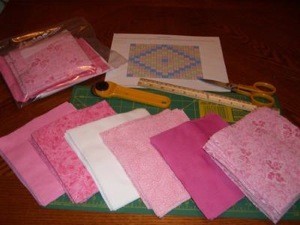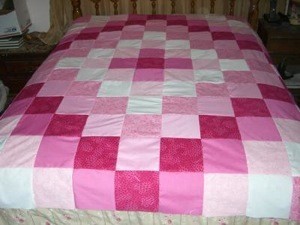The first quilt I ever made was a simple hand sewn patchwork quilt worked in strips at my grandmother's knee. This is a pattern now done on a machine and committed to memory that has been repeated many times over as Christmas, anniversary, wedding, and shower gifts.
The size of the squares can be adjusted to make it fit any size bed, crib or daybed by simply measuring the mattress top, dividing by 6 and adding 1 1/2 inch per square for seam allowances, i.e. if your square is to be 5 x 5 1/2 inches cut your squares at 6 1/2 x 7 inches.
Approximate Time: 12 - 15 hours
When selecting your fabrics, try to stick to the same weight and type of material. Cotton and cotton blends work best and are usually less expensive than most fabrics.
I found after cutting my squares, that the pink butterfly fabric was too heavy or bulky with the other fabrics and had to make a trip back to the fabric store to choose another material. Also, make sure your fabrics are machine washable to avoid dry cleaning bills on such a large item.
Wash, dry, and, iron all fabrics to eliminate the possibility of shrinkage after your quilt is finished.
Once your quilt squares are cut, lay them side by side - plain, pattern, plain (or vice versa) to determine how you want your pattern to work out. The last color will be the most prominent on the quilt. Once you have decided how you want your pieces to lay in the design, assign each fabric a number from 1 to 6 and set them in order on the table so you only have to move down the line when you pick them up from the pile as they are added to your quilt.

*Note: If you have access to a serger and a rotary cutter and mat, I highly recommend using them as it will save 2/3 of the time you will spend cutting squares with scissors, trimming and pressing seams open during the assembly of your quilt and will provide more uniform squares.
If you must cut your squares by hand, pinking shears are your best choice to prevent raveling because of heavy handling and will reduce raised or lumpy areas under your seams.
Starting on row one and following the pattern sheet below, with right sides together match up edges and stitch pieces together at the 5/8's inch mark making one long strip, beginning and ending each row with the same fabric piece.
As you finish each strip, match it lengthwise to the previous sewn strip. If you are using a regular sewing machine, press seams open first. Pin on seam lines with the seams facing the center of the quilt row.
Once you reach the center strip, which will be the same as the first and last squares, you will pin one facing to the right, the next side facing to the left and continue pinning left to the end of the row.
As you add rows to your quilt, it will become too bulky to manage on the machine.
I recommend sewing strips together until you reach the middle row, which will be a repeat of the very first row you made. Set the piece aside and continue making strips, following the pattern for the lower half of the quilt as you did for the upper half.
Once the bottom half is complete, pin it to the upper half and stitch both halves together. This way you only have to deal with the bulk of the quilt once.
At this point, you can add borders to the sides.
If you don't want to add borders, I recommend you buy a flat sheet. It's more economical than purchasing fabric for the back and you don't have to piece it together. Buy it one size larger than your quilt topper. Keeping layers smooth, layer from top to bottom:
From the center out, tie the layers together at various points (about every 9 squares) with embroidery thread or yarn. My preferred method is to machine stitch using the button stitch.
Check both sides to make sure all layers are smooth. If you encounter bunching, simply remove the tie smooth and retie.
Fold the outer edges of the sheet over the raw open edges, leaving a little hangover for a small border, miter in the corners by folding the point over to meet the border and then folding the edge over the top. Top stitch all the way around.
The last picture shows how your quilt will lay on a double bed with the pattern dropping off the outer edges. On a queen size bed it will all lay on top.
By Sew Crafty from CA

Add your voice! Click below to comment. ThriftyFun is powered by your wisdom!